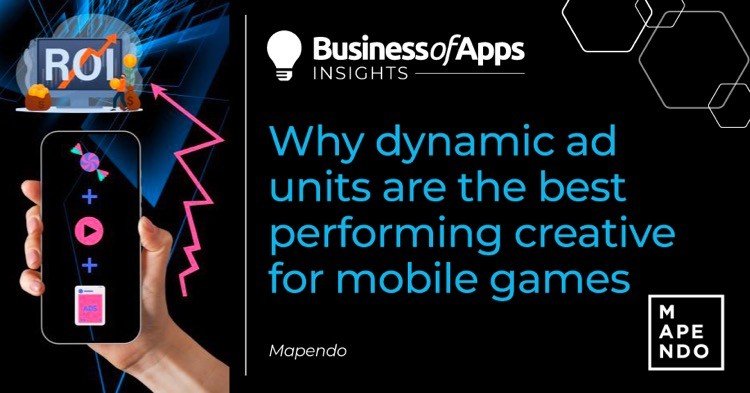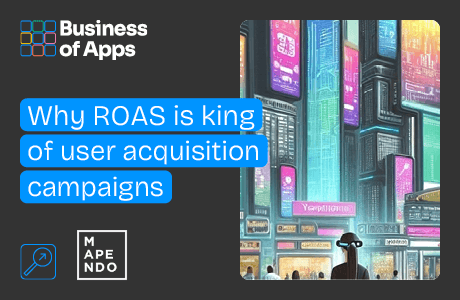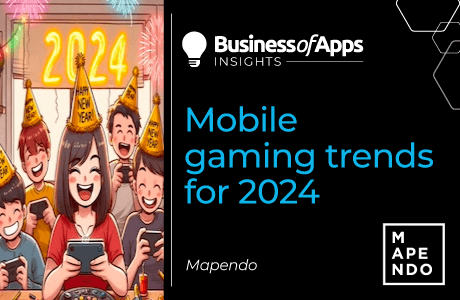Introduction
For a mobile game to have success and achieve installs, graphic and technical perfection are not enough. The advertising strategy employed to promote it, and equally as important the choice of ad creatives used, play a fundamental part.
In fact, the engaging ability of an ad creative is perhaps its most important feature, and every single ad creative presents different rates in terms of user engagement and clicks they are able to attract.
In this context, dynamic ad units stand out as the perfect solution for mobile game developers that want their game to get the largest user base possible.
In this article, we will take a look at the performance of every ad creative that can be used in mobile games advertising and highlight the superiority that dynamic ad units bring for a higher ROI.
The different kinds of ad formats
Banner Ads
Banner ads, whether static or dynamic, are strategically positioned at the top or bottom of the interface, providing a constant presence throughout the user experience. Despite their continuous visibility, banner ads may be perceived as less immersive compared to other ad formats.
Interstitial Ads
In contrast to the subtlety of banner ads, interstitial ads seize the attention by occupying the entire screen. These full-screen ads make their appearance during natural breaks in the user’s session, such as transitions between levels or loading moments. Their prominent visibility and engagement are notable, taking advantage of users’ receptiveness during these intervals.
Native Ads
Native ads seamlessly blend into the game environment, offering a non-disruptive advertising experience. They are less intrusive while effectively reaching and resonating with the target audience and are adaptable to various platforms. This adaptability contributes to their widespread use in digital marketing strategies and mobile app marketing.
Video Ads
Video ads not only effectively capture the attention but also deliver information about the mobile game in a captivating way through visuals. Boasting impressive user engagement and retention rates, video ads seamlessly integrate with other formats like playable ads, interstitial ads, and Apple’s proprietary SKOverlay technology, widely utilized in mobile games.
Playable Ads
One of the most employed formats in mobile games advertising, playable ads introduce an interactive gaming element, allowing users to engage with a mini-game or trial within the ad itself. This unique approach enables users to immerse themselves in a snippet of first-person gameplay. Playable ads have proven to be a highly effective mobile app marketing tool, driving substantial revenue.
Rewarded Video Ads
Another immensely employed ad format in mobile games, rewarded video ads establish a value exchange by offering users incentives such as in-game currency, extra lives, or premium skins in return for watching a video ad. It has been proven that gamers really like rewarded video ads, as this format creates a mutually beneficial scenario for both gamers and advertisers.
An analysis of ad performances
A straightforward contrast between dynamism and staticity shows a clear winner: video ads versus banner ads. Video ads surpass banner ads on multiple fronts, leading with an 86% Click-Through Rate (CTR) compared to the 55% of banner ads, as well as a Conversion Rate (CR) three times higher than that of banners.
Check out Mapendo’s annual report for a further analysis on ad performance.
The captivating content and in-game assets showcased by video ads contribute significantly to heightened user engagement, translating into superior CTRs and conversion rates.
If we turn our attention to two mostly static formats, banner ads and interstitial ads, results can be once again forecasted. In fact, interstitial ads achieve an almost 20 times higher conversion rate than their banner counterparts. This substantial difference can be attributed to the size contrast between the two formats, suggesting that larger ads are more likely to drive increased conversions.
Moreover, banner ads, surely the most used and low-cost but perhaps the least prominent ad format, are susceptible to phenomena such as banner blindness, where users consciously overlook their presence on the interface, and banner fatigue, where extended exposure severely diminishes their impact.
Among the individual ad formats, video ads and playable ads emerge as the standout revenue generators. Both leverage engaging visuals and compelling content to guide users toward conversions and increase user engagement. Playable ads, in particular, exhibit exceptional effectiveness, boasting a conversion rate three times higher than video ads and generally quadrupling or quintupling the conversion rate of other ad creatives.
A distinct consideration arises with rewarded video ads. According to udonis.co, they are perceived as the least disruptive format, given users’ ability to opt-in to watch them for in-game advantages. Nearly 70% of gamers favor this format, with 76% of US-based gamers expressing a preference for rewarded video ads over interstitial ads. This underscores the significant impact disruptions have on public perception. From an economic standpoint, players engaging with rewarded video ads have a six times higher likelihood of completing in-app purchases, thereby enhancing their Life-Time Value (LTV).
The advantage of dynamic ad units
A dynamic ad unit combines different kinds of ad formats, mostly playable ads and video ads, to create a multi-page ad. In particular, it is not uncommon to see a sequence made of a short video ad, a playable ad, and an ending card, which could either consist of another playable ad or of an interstitial ad, with a button that redirects to the app store and to in-house assets.
Articulating a mobile game ad into three different steps and blending video, static and interactive elements allows advertisers to give plenty of room to users to interact and to offer them an enjoyable gaming experience.
After having seen the performance of several ad formats, the conclusion we can draw is that, because video ads and playable ads have definitely proven to be the best-performing ad formats in the business, it stands to reason that a dynamic ad unit in which the two of them are combined can only boost their individual power for an ad that allows for an even bigger impact. This effect is very commonly boosted even more by the use of Apple’s SKOverlay technology for iOS users, which simplifies the install and prevents the interruption of the multi-page ad.
There is another interesting analysis that can be made. While the combination of different dynamic formats enhances the overall impact of the ad, it must be said that the individual ads, if considered alone, keep their typical effect. This consideration can be easily validated by taking a look at the different levels of ROI based on the final touchpoint of a multi-page ad unit.
Let’s take a dynamic ad unit that combines three different ads, a video, a playable and an end card. Users that download the app by clicking on the video, the first of the three ads, show a lower ROI compared to those who engaged with the playable ad. In the same way, the best results in terms of ROI are delivered by the users that stick to the end of the ad and interact with the end card. Therefore, we can infer the following: the more one can keep a user engaged during a dynamic ad unit, the higher the ROI.
Platforms such as DSPs are able to test different combinations of assets with a multi-page ad unit in real time. In doing so, they conduct a constant optimization of ad units toward their prefixed goals.
Conclusion
It goes without saying that the choice of creatives used to promote a mobile game is entirely up to advertisers and developers.
What stays unchanged is the necessity of conducting A/B testing and rotations of different formats in order to collect the largest amount of data and to optimize the user acquisition campaign toward the best-performing formats.
It is equally true that, data at hand, dynamic ad units undoubtedly take the #1 spot in terms of performance among every creative existent.
The choice must fall upon what’s best for the mobile game itself and the budget available for the advertising campaign. Dynamic ad units are more expensive than other kinds of creative, but surely will be the most beneficial in terms of ROI.
Find out how Mapendo incorporated SKOverlay into their proprietary dynamic ad units.











